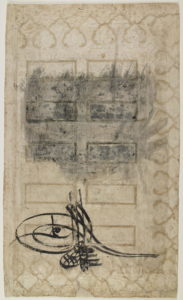Tughras
Not all tughras were meant for public view or were affixed on official letters and documents. This tughra belonged to the Ottoman Sultan Ahmed III and appears on the verso of a 16th-century Safavid Persian single-sheet fragment of a Fal-i Qur’an, or divination of the Qur’an (holy book) by means of letters selected at random. It is that the Qur’an in question traveled from southwestern Iran to the Topkapi Palace Library in Istanbul sometime during the 17th century. The largely effaced date of 1111/1700 on the verso further supports the hypothesis that the Qur’an arrived in Istanbul by the turn of the 18th century. The tughra thus serves as a sort of ‘ex-libris’–a mark of ownership– for Sultan Ahmed III. He also may have ordered removed and pasted certain areas of the recto to conceal the real purpose of the sheet, as prognostication by means of the Holy Book was, and still remains, a problematic practice in Islam.
Further readings:
Ottoman Fermans, Ankara: T.C. Başbakanlık Devlet Arşivleri Genel Müdürlüğü, 2003.
Esin Atil, The Age of Sultan Süleyman the Magnificent, Washington DC: National Gallery of Art, 1987, pp. 36-43.
